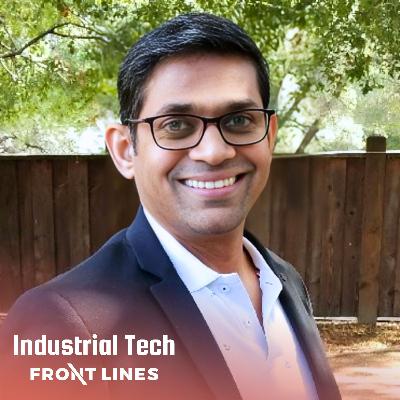How Lincode's move from Silicon Valley to Michigan accelerated automotive customer acquisition | Rajesh Iyengar
Description
Lincode Labs is transforming quality control in automotive manufacturing through AI-powered visual inspection systems that replace traditional machine vision cameras with advanced computer vision technology. After nine years and $10 million in funding, the company has established itself as an early mover in bringing modern AI to one of manufacturing's most conservative sectors. In this episode of Category Visionaries, I spoke with Rajesh Iyengar, a fourth-time founder with multiple exits, about his methodical approach to market validation, the operational realities of selling into automotive manufacturing, and the counterintuitive GTM strategies that enabled market penetration in a notoriously risk-averse industry.
Topics Discussed:
- Pre-incorporation market validation methodology: surveying 300-400 manufacturers over one year
- Positioning within existing "vision systems" budget categories versus creating new AI category
- Manufacturing engineer versus quality engineer buyer persona discovery and implications
- Trade show strategy for demonstrating complex AI technology to skeptical prospects
- Geographic arbitrage: leveraging Silicon Valley for fundraising, Michigan for customer proximity
- Structured investor feedback collection across 400-500 pitches for business model refinement
GTM Lessons For B2B Founders:
- Execute systematic pre-incorporation market validation at scale: Before incorporating Lincode, Rajesh spent an entire year surveying 300-400 manufacturers through a structured questionnaire approach. Starting with 8-10 manufacturing contacts, he expanded through LinkedIn outreach to validate core assumptions about AI adoption, deployment complexity, and willingness to pay. This wasn't casual customer discovery—it was quantitative market research that de-risked his fourth venture before committing capital. B2B founders should design systematic validation processes that generate statistically meaningful data rather than relying on anecdotal feedback from a handful of prospects.
- Position within existing budget categories to accelerate procurement cycles: Despite building AI technology, Rajesh deliberately positioned Lincode within the established "vision systems" category rather than creating a new AI category. As he explained, "as far as customer is concerned, whether it's AI or not AI, they'll put us into a category of vision systems... so they can assign the budgets." Creating new categories extends sales cycles as procurement teams struggle with budget allocation and vendor evaluation frameworks. B2B founders should analyze how their innovation maps to existing enterprise budget line items and position accordingly, reserving category creation for later market education phases.
- Identify economic buyers through productivity impact mapping, not feature alignment: Lincode's initial assumption that quality engineers would buy quality inspection technology proved completely wrong. Manufacturing engineers became the actual buyers because quality bottlenecks directly constrained their core KPI: productivity. Rajesh discovered that "manufacturing engineers responsibility is on productivity, so quality kind of puts a bottleneck on that." This required repositioning their value proposition from quality improvement to productivity optimization. B2B founders must map their solution's economic impact across organizational functions to identify who controls budget decisions, which often differs from the obvious feature-benefit alignment.
- Deploy experiential marketing for technology adoption in conservative industries: Traditional SaaS demo strategies failed in automotive manufacturing where "AI is something which nobody wanted to just believe on a buzzword, especially in Midwest." Rajesh invested in major trade shows with hands-on demos, allowing prospects to physically interact with components and see real-time AI analysis. This strategy mimicked automotive showroom experiences where customers need tactile engagement before purchasing decisions. For B2B founders selling complex technology to traditional industries, budget allocation should prioritize experiential marketing that enables physical product interaction over digital marketing channels.
- Structure investor feedback as systematic business model iteration: Rather than fundraising episodically, Rajesh treated investor pitches as structured feedback collection, comparing it to AI model training: "if you give thousands of images, then the AI will work perfectly." Pitching 400-500 investors generated business model insights that shaped core strategic decisions, including the critical industry focus recommendation that transformed their approach. One investor's feedback about avoiding multi-industry approaches directly contradicted Rajesh's initial strategy but proved transformational. B2B founders should design investor interaction as ongoing strategic consulting, maintaining regular dialogue for continuous business model refinement beyond capital needs.
//
Sponsors:
Front Lines — We help B2B tech companies launch, manage, and grow podcasts that drive demand, awareness, and thought leadership.
The Global Talent Co. — We help tech startups find, vet, hire, pay, and retain amazing marketing talent that costs 50-70% less than the US & Europe.
//
Don't Miss: New Podcast Series — How I Hire
Senior GTM leaders share the tactical hiring frameworks they use to build winning revenue teams. Hosted by Andy Mowat, who scaled 4 unicorns from $10M to $100M+ ARR and launched Whispered to help executives find their next role.
Subscribe here: https://open.spotify.com/show/53yCHlPfLSMFimtv0riPyM
























